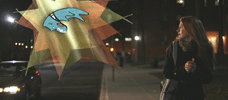Reviews
Jay Duplass & Mark Duplass
USA, 2008
Credits
Review by Rumsey Taylor
Posted on 18 March 2008
Source Sony Pictures Classics 35mm print
Categories The 2008 South by Southwest Film Festival
Baghead has four central characters - two men, two women, each misconceiving relationships with one another - and we are introduced to them in an audience of a festival screening of We Are Naked. It is a laughably sincere black and white film, concluding, naturally, with a man and a woman eschewing their clothing and embracing each other (and figuratively each other’s nakedness) in a suburban street. The crowd applauds, and afterward the director is summoned to the front of the theater to answer questions—it is at this instant that Baghead’s self-consciousness becomes clear, and the film spends its remainder deftly orchestrating its audience’s responses as well as their conception of exactly what sort of film it is.
This scene ingeniously mirrors the context in which I saw the film, with a crowd of people with lanyards looped around their necks, and the filmmakers in attendance. This context forwards a particular insularity: the crowd is generally enthusiastic because the films in exhibition are typically low budget premiers, for which someone inured a substantial debt to make. The experience engenders a leniency in criticism; you’re applauding the fact that these films were made, period, and your perception of their faults is perhaps more forgiving than it would be in most any other context. This is also something Baghead is aware of. And if you find the audience’s response to We Are Naked curiously enthusiastic, you’re more equipped to anticipate the larger scheme in which the viewer is himself enveloped.
Baghead postures itself as a low-budget film with ample improvisation; at least, it uses these aspects to obscure its deeper machination, blindsiding its audience with moments of fright and hilarity. The four characters are young and chatty, their dialogue often broken, interruptive, and nuanced, and much of the film seems to happen on a whim. It begins with the four deciding on the spur to go to a cabin in the woods for the weekend, returning with the foundation of a script for their own film. They depart with lots of enthusiasm and no ideas, and the first night there they get drunk, retiring shortly afterward with only a basic idea: a slasher killer who obscures his identity with a paper bag.
Slasher killers are cinematic icons, and as such become less potent the more recognizable they become. Baghead in terms of characterization - as a killer who is not recognizably threatening - reduces the notion of the slasher killer to its very essence: he is human, but not supernaturally so, and he has a disguise so you’re not able to explicitly identify him.1 He could be anyone. He could be crouched outside your window at this very instant.
The four people haven’t set out to write a horror film, which is important to keep in mind. Although their basic intention is to return with something that resembles a concept for a film, the visit doubles as an opportunity to sort out some romantic tensions. Chad, for one, is in his late thirties, his hair losing any propensity for style, and he’s keen on Michelle. She returns none of his advances, but is outright in elbowing Matt, the second guy, toward a vacant bedroom one evening, via a note she slips to him discreetly. At about two in the morning, she’s met with a visit from Baghead, who exits without revealing his identity, the horror setting in once she finds and awakens Matt, who is not responsible for the visit. The reason this scene possesses so much tension is precisely because you’re not expecting it. Baghead isn’t shot like a horror film, and spends little time establishing its characters before putting them in peril. Its horror isn’t anticipated because there’s nothing about these people that justifies harm—there’s no sex, no character flaws that warrant violent reciprocation; they’re just people, not pawns. But this, as with perception of what sort of film this is, isn’t ultimately certain.
In concept and execution Baghead resembles the Duplass brothers’ previous film, The Puffy Chair, a road-trip movie also with four central characters. It possesses a similarly sporadic air about it; both films feel like they’re progressing with little directorial imperative. But unlike The Puffy Chair, Baghead ultimately feels orchestrated. Its ingenuity is in how it engenders and then subverts expectations. Much like the final third of Adaptation (but in a much more assured fashion), Baghead is in whole a film aware of itself, aware of its own fiction and the very real responses it is capable of provoking.
^1^ Baghead does resemble Jason Vorhees’ disguise in Friday the 13th Part II, but I suspect the resemblance is coincidental. ↩
More The 2008 South by Southwest Film Festival
-

Obscene
2007 -

21
2007 -

The Toe Tactic
2008 -

The Order of Myths
2008 -

Baghead
2008 -

Beautiful Losers
2008 -

Paper Covers Rock
2008 -

The Lost Coast
2008 -

Yeast
2008 -

Explicit Ills
2008 -

Natural Causes
2008 -

A Necessary Death
2008 -

Nights and Weekends
2008
We don’t do comments anymore, but you may contact us here or find us on Twitter or Facebook.



